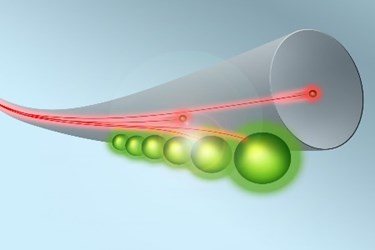Entry Into The Zeptosecond Measurement

When light strikes electrons in atoms, their state changes in unimaginably short periods of time. The laser physicists of the Max Planck Institute for Quantum Optics (MPQ), the Technical University of Munich (TUM) and the Ludwig-Maximilians-University (LMU) of Munich have developed such a phenomenon, namely photoionization, in which an electron exits a helium atom after light excitation For the first time with Zeptosecond accuracy. A Zeptosekunde is a trillionth of a billionth of a second (10 -21 seconds). This is the highest accuracy of the time determination of an event in the microcosm that has ever been achieved, as well as the first absolute determination of the time of photoionization.
If light hits the two electrons of a helium atom, then you have to be extremely fast to observe the events. In addition, quantum mechanics occur: if a light particle (photon) hits the two electrons, it can happen that the entire energy of the photon is either absorbed or divided by the one electron.
In any case of the energy transfer, however, an electron leaves the helium atom. This process is called photoemission or photoelectric effect. Albert Einstein received the Nobel Prize in 1921 for his declaration.
From the time at which the photon with the electron interacts until the time at which an electron leaves the atom, it takes between five and fifteen attosecond (1 as 10-18 seconds). The physicists found this a few years ago.
Insight into the world of Zeptoseconds
With their now improved measurement method, the laser physicists can accurately measure the events up to 850 Zeptosekunden. The researchers sent an extremely ultraviolet light (XUV) attosecond to a helium atom to excite the electrons.
At the same time they were hitting a second infrared laser pulse, which lasted about four femtoseconds (1 fs is 10 -15 seconds). As soon as the electron had left the atom by the excitation of the XUV light, it was detected by the infrared laser pulse.
Depending on the exact electromagnetic field of this pulse at the time of detection, the electron was accelerated or decelerated. Through this change in speed, the physicists were able to measure the photoemission with the help of Zeptosecond precision.
In line with theoretical predictions
For the first time the researchers determined how the energy of the incident photon had spread to the two electrons of the helium atom in a few attoseconds before the emission of a particle quantum mechanically.
"With the measurement of electronic correlation here a promise of attosecond physics has been redeemed, namely the temporal resolution of a process that is unattainable with other methods," says Kienberger , Chair of Laser and X-Ray Physics at the TU Munich.
In addition, the physicists were able to correlate the precision of their experiments with the theoretical predictions of their colleagues from the Institute for Theoretical Physics of the Vienna University of Technology, with the exception of Zeptosecond accuracy.
With its two electrons, helium is the only multi-electron system that can be calculated completely quantum mechanically. This makes it possible to reconcile theory and experiment.
"We can now derive the complete wave-mechanical description of the system from our measurements in the entangled system of electron and ionized helium-motheratom," says Schultze of the Max Planck Institute for Quantum Optics, Garching.
With their metrology experiments in Zeptosecond time dimensions, the laser physicists have thus maneuvered another important puzzle piece in the quantum mechanics of the helium atom to the right place and advanced the measurement accuracy in the microcosm to a whole new dimension.
The work was funded by the Max Planck Society, the German Research Foundation (DFG), the Excellence Cluster Munich-Center for Advanced Photonics, the Austrian Science Fund and the European Community (through two ERC grants and the Marie Curie program). In addition to the TU Munich and LMU Munich as well as the Max Planck Institute for Quantum Optics in Garching, the Technical University of Vienna and the Universidad Autónoma de Madrid participated in the project.
Source: Technische Universität München
